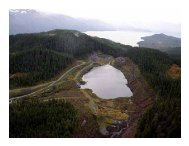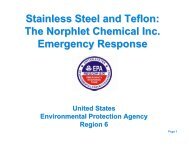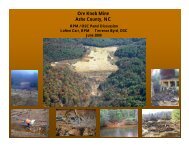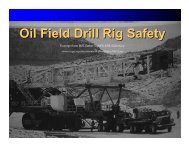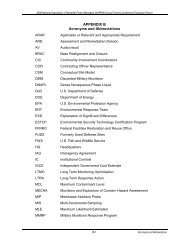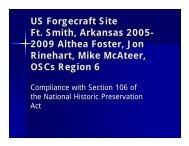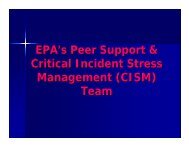Oil Spill Response Drills and Exercises under the FRP new.pdf
Oil Spill Response Drills and Exercises under the FRP new.pdf
Oil Spill Response Drills and Exercises under the FRP new.pdf
- No tags were found...
Create successful ePaper yourself
Turn your PDF publications into a flip-book with our unique Google optimized e-Paper software.
Contents‣ Introduction: Why exercise? Authority for Conducting <strong>Drills</strong>Troy Swackhammer, OSWER/OEM‣ PART I: Background: Facility <strong>Response</strong> Plan Regulation &Preparedness FrameworkTed Walden, Region 4‣ PART II: <strong>FRP</strong> Training <strong>and</strong> Exercise RequirementsArlene Anderson, Region 1‣ PART III: Implementing a GIUE <strong>and</strong> “The Good, <strong>the</strong> Bad,<strong>and</strong> <strong>the</strong> Ugly”Arlene <strong>and</strong> Ted<strong>Drills</strong> <strong>and</strong> <strong>Exercises</strong> at <strong>FRP</strong> Facilities February 20103
Introduction: Authority forConducting <strong>Drills</strong>/<strong>Exercises</strong>‣ <strong>Oil</strong> Pollution Act of 1990• 311(j)(6)(A): Equipment Inspections• 311(j)(7): Tests of Facility Removal Capability‣ National Contingency Plan (NCP)• Area Contingency Plan (ACP)• Facility <strong>Response</strong> Plan (<strong>FRP</strong>) regulation requiresfacility response drills/exercises• Program must follow National Preparedness for <strong>Response</strong>Exercise Program (PREP) (or alternative format approved by<strong>the</strong> Regional Administrator) [112.21(c)]‣ National <strong>Response</strong> Framework<strong>Drills</strong> <strong>and</strong> <strong>Exercises</strong> at <strong>FRP</strong> Facilities February 20105
Introduction: Authority forConducting <strong>Drills</strong>/<strong>Exercises</strong>‣ National Preparedness for <strong>Response</strong>Exercise Program (PREP)• Requires unannounced exercises by EPA,U.S. Coast Guard (USCG), MineralsManagement Services (MMS), <strong>and</strong> Pipeline<strong>and</strong> Hazardous Materials Safety Administration(PHMSA (listed as RSPA in PREP))<strong>Drills</strong> <strong>and</strong> <strong>Exercises</strong> at <strong>FRP</strong> Facilities February 20106
Introduction: Authority forConducting <strong>Drills</strong>‣ EPA Regulated Facilities (40 CFR part 112)• Non-TransportationTransportation-Related Onshore Facilities <strong>and</strong>Certain Offshore Facilities‣ USCG Regulated Facilities (33 CFR parts 154 <strong>and</strong> 155)• Vessels <strong>and</strong> Marine-TransportationTransportation-Related FacilitiesRSPA (now PHMSA)‣ RSPA• Pipelines(now PHMSA) Regulated Facilities (49 CFR part 194)‣ MMS Regulated Facilities (30 CFR part 254)• Offshore Facilities (i.e., located seaward of <strong>the</strong> coast line)‣ Complexes-Subject to Two or More Agencies• Agencies must coordinate efforts to avoid repeatingexercises<strong>Drills</strong> <strong>and</strong> <strong>Exercises</strong> at <strong>FRP</strong> Facilities February 20107
PART IBackground: Facility <strong>Response</strong>Plan Regulation &Preparedness Framework8
<strong>Oil</strong> Pollution Act of 1990 <strong>and</strong>Clean Water Act‣ Section 311(j)(5) of CWA, amended by OPA1990‣ A Facility <strong>Response</strong> Plan shall:• (i) be consistent with <strong>the</strong> requirements of <strong>the</strong> NationalContingency Plan <strong>and</strong> Area Contingency Plans;• (ii) identify <strong>the</strong> qualified individual having full authority toimplement removal actions, , <strong>and</strong> require immediatecommunications between that individual <strong>and</strong> <strong>the</strong>appropriate Federal official <strong>and</strong> <strong>the</strong> persons providingpersonnel <strong>and</strong> equipment pursuant to clause (iii);<strong>Drills</strong> <strong>and</strong> <strong>Exercises</strong> at <strong>FRP</strong> Facilities February 20109
<strong>Oil</strong> Pollution Act of 1990 <strong>and</strong>Clean Water Act (cont’d)• (iii) identify, <strong>and</strong> ensure by contract or o<strong>the</strong>r meansapproved by <strong>the</strong> President <strong>the</strong> availability of, privatepersonnel <strong>and</strong> equipment necessary to remove to <strong>the</strong>maximum extent practicable a worst case discharge(including a discharge resulting from fire or explosion), <strong>and</strong>to mitigate or prevent a substantial threat of such adischarge;• (iv) describe <strong>the</strong> training, equipment testing, periodicunannounced drills, , <strong>and</strong> response actions of persons on<strong>the</strong> vessel or at <strong>the</strong> facility, to be carried out <strong>under</strong> <strong>the</strong> planto ensure <strong>the</strong> safety of <strong>the</strong> vessel or facility <strong>and</strong> to mitigateor prevent <strong>the</strong> discharge, or <strong>the</strong> substantial threat of adischarge;• (v) be updated periodically; <strong>and</strong>• (vi) be resubmitted for approval of each significant change.<strong>Drills</strong> <strong>and</strong> <strong>Exercises</strong> at <strong>FRP</strong> Facilities February 201010
EPA’s s <strong>FRP</strong> Regulation‣ 40 CFR part 112, Sections 112.20 <strong>and</strong> 112.21,Appendices C - F‣ §112.20- Requirements to prepare plans to respond toworst-case discharge of oil• Substantial harm criteria include:• 42,000 gallons or more in oil storage capacity <strong>and</strong> transfers oil overwater to/from vessel• 1 million gallons or greater in oil storage capacity, <strong>and</strong> one or more of<strong>the</strong> following:• Inadequate sized secondary containment• Could impact fish <strong>and</strong> wildlife <strong>and</strong> sensitive environments• Could shut down a public drinking water intake• Had reportable discharge of 10,000 gallons or more in last 5 years• O<strong>the</strong>r factors as determined by Regional Administrator• EPA must approve <strong>the</strong> plans for significant <strong>and</strong> substantial harmfacilities.<strong>Drills</strong> <strong>and</strong> <strong>Exercises</strong> at <strong>FRP</strong> Facilities February 201011
EPA’s s <strong>FRP</strong> Regulation (cont’d)‣ §112.21- Requirements for training <strong>and</strong> program ofdrills/exercises• Training (§112.21(b))(• Train personnel involved in oil spill response activities• Recommendation that training program be based on USCG’sTraining Elements for <strong>Oil</strong> <strong>Spill</strong> <strong>Response</strong>• Alternative program may be acceptable, subject to approval by <strong>the</strong>Regional Administrator• Facility <strong>Response</strong> <strong>Drills</strong>/<strong>Exercises</strong> (§112.21(c))(• Develop a program of drills/exercises, including evaluationprocedures• Program ei<strong>the</strong>r follows National Preparedness for <strong>Response</strong>Exercise Program (PREP) will satisfy <strong>the</strong> requirement – commonor…• Alternative exercise program may be acceptable, subject toapproval by <strong>the</strong> Regional Administrator – not common<strong>Drills</strong> <strong>and</strong> <strong>Exercises</strong> at <strong>FRP</strong> Facilities February 201012
Universe of <strong>FRP</strong> Facilities3811641844612583021362571,608499Current Count: approx. 4,250 <strong>FRP</strong> Plan holders<strong>Drills</strong> <strong>and</strong> <strong>Exercises</strong> at <strong>FRP</strong> Facilities February 201013
<strong>FRP</strong> Facility CharacteristicsIndustry Sectors, by number of <strong>FRP</strong>Facilities*• Electric power generation, transmission<strong>and</strong> distribution (30%)• Petroleum <strong>and</strong> petroleum productswholesalers (23%)• Petroleum <strong>and</strong> coal productsmanufacturing (7%)• National security <strong>and</strong> international affairs(6%)• Grain <strong>and</strong> oilseed milling (6%)• Warehousing <strong>and</strong> storage (4%)• Pipeline transportation (3%)• O<strong>the</strong>r sectors (23%), including• Basic chemical manufacturing (2%)• Pulp/paper manufacturing (2%)• Support for air/rail/water transportation (2%)• <strong>Oil</strong> <strong>and</strong> gas extraction (1%)AverageFacility total storage capacity (gal)• Electric power generation, transmission<strong>and</strong> distribution (10.4 M)• Petroleum <strong>and</strong> petroleum productswholesalers (11.2 M)• Petroleum <strong>and</strong> coal productsmanufacturing (23.5 M)• National security <strong>and</strong> international affairs(5.2 M)• Grain <strong>and</strong> oilseed milling (4.7 M)• Warehousing <strong>and</strong> storage (20.6 M)• Pipeline transportation (25.5 M)• O<strong>the</strong>rs sectors, including• Basic chemical manufacturing (1.9 M)• Pulp/paper manufacturing (2.4 M)• Support for air transportation (10.8 M)• Support for water transportation (4.5 M)• Support for rail transportation (1.4 M)• <strong>Oil</strong> <strong>and</strong> gas extraction (6.6 M)* Based on 1,872 facilities (of 4,143 facilities total) with available NAICS/SIC sector <strong>and</strong> storage capacity information<strong>Drills</strong> <strong>and</strong> <strong>Exercises</strong> at <strong>FRP</strong> Facilities February 201014
National<strong>Spill</strong> Contingency PlanningFrameworkNational Contingency PlanNational <strong>Response</strong> Team16 Federal AgenciesRegionalArea Contingency PlansRegional <strong>Response</strong> TeamFederal agencies, State <strong>and</strong> Local governmentArea 1 Area 2 Area … Sub-AreasLocal / FacilityFacility <strong>Response</strong> PlansFacility owner/operator<strong>Spill</strong> response contractorsFacility 1 Facility 2 Facility …<strong>Drills</strong> <strong>and</strong> <strong>Exercises</strong> at <strong>FRP</strong> Facilities February 201015
<strong>Spill</strong> Contingency Planning<strong>Drills</strong> <strong>and</strong> <strong>Exercises</strong>National‣ <strong>Spill</strong> Of National Significance (SONS)ExerciseRegional‣ Area ExerciseLocal / Facility‣ Facility Exercise<strong>Drills</strong> <strong>and</strong> <strong>Exercises</strong> at <strong>FRP</strong> Facilities February 201016
Area Exercise‣ Purpose: : Evaluate <strong>the</strong> entire pollution responsemechanism in a given geographic area toensure adequate response preparedness.‣ Involve government <strong>and</strong> industry responders.‣ Triennial schedule maintained by U.S. CoastGuard• Schedule published in <strong>the</strong> Federal Register• Based on calendar years<strong>Drills</strong> <strong>and</strong> <strong>Exercises</strong> at <strong>FRP</strong> Facilities February 201018
Facility Exercise‣ Purpose: : Demonstrate timely, properlyconducted response that follows <strong>the</strong> <strong>FRP</strong>with adequate equipment for a smalldischarge.• Internal Exercise: : Initiated by facilityowner/operator• External Exercise: : Government-initiated (e.g.,GIUE)<strong>Drills</strong> <strong>and</strong> <strong>Exercises</strong> at <strong>FRP</strong> Facilities February 201019
<strong>FRP</strong> Content1. Emergency <strong>Response</strong> Action Plan (ERAP)2. Facility Information3. Information about Emergency <strong>Response</strong>4. Hazard Evaluation5. <strong>Response</strong> Planning Levels6. Discharge Detection Systems7. Plan Implementation8. Self-Inspection, <strong>Drills</strong>/<strong>Exercises</strong>, <strong>and</strong> <strong>Response</strong>Training9. Diagrams10. Security Systems11. <strong>Response</strong> Plan Cover Sheet<strong>Drills</strong> <strong>and</strong> <strong>Exercises</strong> at <strong>FRP</strong> Facilities February 201020
<strong>FRP</strong> <strong>Spill</strong> <strong>Response</strong>Planning LevelsPlanningscenarioSmallMedium<strong>Oil</strong> volume2,100 gallons or lessGreater than 2,100 gallons but less than or equal to 36,000 gallonsor 10 percent of largest tank at facility, whichever is lessWorst CaseCalculated based on type of facility, number of containers, whe<strong>the</strong>rsecondary containment is adequate, <strong>and</strong> capacity of largestaboveground storage tank (AST).Often <strong>the</strong> capacity of <strong>the</strong> largest AST.<strong>Drills</strong> <strong>and</strong> <strong>Exercises</strong> at <strong>FRP</strong> Facilities February 201021
Scenario Description‣ For each scenario, address factors that affect responseefforts, including:• <strong>Spill</strong> volume• Material discharged• Location of discharged material• Direction of spill pathway• Proximity to wells, waterways, drinking water intakes, fish <strong>and</strong> wildlife,<strong>and</strong> sensitive environments• Wea<strong>the</strong>r or aquatic conditions• Likelihood that <strong>the</strong> discharge will travel offsite• Probability of a chain reaction of failures• Available remediation equipment• Circumstances <strong>and</strong> contributing factors (e.g. loading/unloading, facilitymaintenance, facility piping, pumping stations <strong>and</strong> pumps, bulk storage scontainers, vehicle refueling, age <strong>and</strong> condition of facility <strong>and</strong>components)<strong>Drills</strong> <strong>and</strong> <strong>Exercises</strong> at <strong>FRP</strong> Facilities February 201022
<strong>Response</strong> Capability: General‣ Demonstrate availability of response personnel <strong>and</strong>equipment necessary to respond within <strong>the</strong> specified times‣ Resources may be ensured by “contract or o<strong>the</strong>r approvedmeans”• Written contractual agreement with <strong>Oil</strong> <strong>Spill</strong> Removal Organization(OSRO)• Written certification by <strong>the</strong> owner or operator that <strong>the</strong> necessarypersonnel <strong>and</strong> equipment are available to respond to a dischargewithin appropriate response times• Active membership in local or Regional cooperative• O<strong>the</strong>r arrangement approved by <strong>the</strong> RA upon request by <strong>the</strong> owneror operator‣ <strong>Spill</strong> <strong>Response</strong> Planning Tiers are specified in Appendix Eto 40 CFR part 112<strong>Drills</strong> <strong>and</strong> <strong>Exercises</strong> at <strong>FRP</strong> Facilities February 201023
<strong>Response</strong> Capability: Small DischargeAppendix E, Section 3.3:The response resources shall, as appropriate, include:EquipmentCapacityTimelineCitationContainmentBoom*1,000 feet orTwice <strong>the</strong> length of <strong>the</strong> largestvessel that regularly conducts oiltransfers to or from <strong>the</strong> facilityMeans of deployingwithin 1 hour of <strong>the</strong>discovery of an oildischargeAppendix E,Section 3.3.1(whichever is greater)<strong>Oil</strong> RecoveryDevicesEffective daily recovery capacityequal to <strong>the</strong> amount of oildischarged in a small dischargeor greaterAvailable at <strong>the</strong> facilitywithin 2 hours of <strong>the</strong>discovery of an oildischargeAppendix E,Section 3.3.2<strong>Oil</strong> StorageCapacityDaily storage capacity equivalentto twice <strong>the</strong> effective dailyrecovery capacity, unless <strong>the</strong>owner/operator can show that alower capacity is adequateAvailable at <strong>the</strong> facilityAppendix E,Section 12.2* O<strong>the</strong>r means of containment may be appropriate for inl<strong>and</strong> facility (see next)<strong>Drills</strong> <strong>and</strong> <strong>Exercises</strong> at <strong>FRP</strong> Facilities February 201024
Containment Boom Alternatives‣ “As Appropriate”‣ For example:• Alternative strategy may be more appropriate forinl<strong>and</strong> facilities, where spill pathway could be a drydrainage pathway or tributary• Alternatives include:• Underflow dams• Temporary containment dams (soil, etc.)• Inflatable diaphragms<strong>Drills</strong> <strong>and</strong> <strong>Exercises</strong> at <strong>FRP</strong> Facilities February 201025
Alternative Methods‣ Open creek‣ Difficult access‣ Debris <strong>and</strong> vegetationuncontrolled‣ Requires differenttype of boom<strong>Drills</strong> <strong>and</strong> <strong>Exercises</strong> at <strong>FRP</strong> Facilities February 201026
Addressing alternative methods‣ Access <strong>and</strong>deployment ability‣ Appropriateequipment for <strong>the</strong>environment <strong>and</strong>access point<strong>Drills</strong> <strong>and</strong> <strong>Exercises</strong> at <strong>FRP</strong> Facilities February 201027
Alternative Methods‣ City re-routing routing <strong>the</strong>drainage of creek‣ Effluent dischargeupgrade by <strong>the</strong> facility‣ <strong>Spill</strong> gate at dischargepoint‣ Access to deploymentarea improved<strong>Drills</strong> <strong>and</strong> <strong>Exercises</strong> at <strong>FRP</strong> Facilities February 201028
PART II<strong>FRP</strong> Training, Inspections<strong>and</strong> ExerciseRequirements29
<strong>Response</strong> Training‣ Must provide adequate training for QI, facility personnel,<strong>and</strong> spill management teams‣ Training scope examples:• QI <strong>and</strong> Facility Personnel training• Notification procedures, communication systems, internal responseorganizations• Procedures for mitigating a discharge or threat of a discharge,including site safety <strong>and</strong> security• Hazard recognition <strong>and</strong> evaluation <strong>and</strong> emergency <strong>and</strong> evacuationprocedures• <strong>Spill</strong> Management Teams• Procedures for use of facility response equipment• Information on oil containment, oil recovery methods <strong>and</strong> devices,equipment limitations <strong>and</strong> uses, use of dispersants, waste storage e <strong>and</strong>disposal methods‣ Training is reinforced by drills/exercises<strong>Drills</strong> <strong>and</strong> <strong>Exercises</strong> at <strong>FRP</strong> Facilities February 201030
‣ QI Interview<strong>FRP</strong>-related InspectionActivities• Evaluate overall knowledge of <strong>the</strong> person(s) identifiedas QI or key personnel in <strong>the</strong> Plan <strong>and</strong> who would becharged with directing/performing response actions.‣ Field inspection• Verify <strong>the</strong> implementation of <strong>the</strong> preparednessmeasures described in <strong>the</strong> <strong>FRP</strong>.‣ Government-Initiated Unannounced Exercise• Verify that facility is able to activate its plan<strong>and</strong> respond to a simulated discharge incident.<strong>Drills</strong> <strong>and</strong> <strong>Exercises</strong> at <strong>FRP</strong> Facilities February 201031
QI Interview‣ Verify that QI <strong>under</strong>st<strong>and</strong>s responsibilities <strong>and</strong> is <strong>the</strong> personresponsible for implementing <strong>the</strong> facility’s s <strong>FRP</strong>.‣ Discussion topics, regarding <strong>the</strong> h<strong>and</strong>ling of a worst-case discharge:• Discharge discovery <strong>and</strong> assessment• Notifications <strong>and</strong> mitigation measures• Temporary storage of recovered product <strong>and</strong> contaminatedmaterials• Treatment <strong>and</strong> disposal of contaminated materials• Roles <strong>and</strong> responsibilities of response team <strong>and</strong> o<strong>the</strong>r facility or ocontractor employees• Incident comm<strong>and</strong> <strong>and</strong> control• Training, exercise, <strong>and</strong> evaluation<strong>Drills</strong> <strong>and</strong> <strong>Exercises</strong> at <strong>FRP</strong> Facilities February 201032
Field Inspection‣ Hazard evaluation <strong>and</strong> vulnerability analysis• Are assumptions reasonable given facility conditions? Reviewdischarge history, areas where discharges could occur, anticipatedspill pathway (e.g., storm drains)• Are <strong>the</strong>re vulnerable sites not considered in <strong>the</strong> plan (e.g., waterintakes, residential or recreational areas, wetl<strong>and</strong>s)?‣ Worst-case discharge scenario <strong>and</strong> planned responseactions• Are assumptions regarding volume <strong>and</strong> failure mode reasonable?Confirm tankage <strong>and</strong> secondary containment• Have <strong>the</strong>re been changes in <strong>the</strong> facility characteristics not reflectedectedin <strong>the</strong> current version of <strong>the</strong> Plan?<strong>Drills</strong> <strong>and</strong> <strong>Exercises</strong> at <strong>FRP</strong> Facilities February 201033
Field Inspection (cont’d)‣ <strong>Spill</strong> response equipment• Type <strong>and</strong> amount available at <strong>the</strong> facility? Adequate quantities?Readily accessible? In working condition?• Contract with <strong>Oil</strong> <strong>Spill</strong> Removal Organization? Is it current?‣ Discharge detection equipment <strong>and</strong> procedures• Review logs <strong>and</strong> records of equipment inspection, assessemployee knowledge of required procedures‣ Security measures• Implementation of emergency cut-offs, fencing, locking of valves,<strong>and</strong> lighting, as required <strong>under</strong> <strong>the</strong> SPCC rule.<strong>Drills</strong> <strong>and</strong> <strong>Exercises</strong> at <strong>FRP</strong> Facilities February 201034
Facility <strong>Drills</strong> <strong>and</strong> <strong>Exercises</strong>‣ Use <strong>the</strong> National Preparedness <strong>and</strong> <strong>Response</strong> ExerciseProgram (PREP) guidelines or equivalent• Combination of internal <strong>and</strong> external exercises• Range of exercises covering all aspects of <strong>the</strong> <strong>FRP</strong> over a 3-year 3cycle• Satisfies all OPA-m<strong>and</strong>ated Federal <strong>Oil</strong> Pollution <strong>Response</strong> ExerciseRequirements• All alternative programs must be approved by <strong>the</strong> RegionalAdministrator prior to implementation‣ Facility receives credit for Area or Facility-specific exercisesfor actual response to a spill if:Plan was utilized for responsePREP objectives were metThe response was properly evaluated, documented, <strong>and</strong> self-certified<strong>Drills</strong> <strong>and</strong> <strong>Exercises</strong> at <strong>FRP</strong> Facilities February 201035
PREPPREP document is available electronically at: http://www.au.af.mil/au/awc/awcgate/uscg/prep_gid.<strong>pdf</strong>36<strong>Drills</strong> <strong>and</strong> <strong>Exercises</strong> at <strong>FRP</strong> Facilities February 2010
PREP Exercise ComponentsElementFrequency*InitiatingAuthorityNotesQI Notification<strong>Exercises</strong>QuarterlyFacility owneror operatorEmergencyProcedures<strong>Exercises</strong>QuarterlyFacility owneror operatorOptional: can be used by facilities as anunannounced exercise.<strong>Spill</strong> ManagementTeam TabletopExerciseAnnuallyFacility owneror operatorAt least one exercise every 3 years mustinvolve a worst-case discharge scenario.EquipmentDeployment<strong>Exercises</strong>SemiannuallyFacility owneror operatorIf OSRO-owned equipment is identified in<strong>the</strong> Plan, <strong>the</strong> OSRO equipment must alsobe deployed <strong>and</strong> operated. OSRO mustprovide documentation to facility owner oroperator.Government-TrienniallyEPA, RSPA,If successfully completed, <strong>the</strong> facilityInitiatedUSCGcan only be subject to a GIUE onceUnannouncedevery 3 years.<strong>Exercises</strong>* At least one exercise per year must be unannounced.37<strong>Drills</strong> <strong>and</strong> <strong>Exercises</strong> at <strong>FRP</strong> Facilities February 2010
Coordination‣ Coordination with o<strong>the</strong>r agencies duringdrill/exercise‣ Regulatory jurisdiction vs. responsejurisdiction‣ Region 1 experience coordinating withU.S. Coast Guard<strong>Drills</strong> <strong>and</strong> <strong>Exercises</strong> at <strong>FRP</strong> Facilities February 201038
PART IIIImplementing a GIUE39
Preparing for a GIUE‣ Outreach to potential c<strong>and</strong>idate <strong>FRP</strong> facilities• General Awareness outreach• Letters, mailings• Information sessions, seminars, webcasts• Emails• Attendance at conferences <strong>and</strong> trade shows• No advance notification of potential for a GIUE<strong>Drills</strong> <strong>and</strong> <strong>Exercises</strong> at <strong>FRP</strong> Facilities February 201040
Preparing for a GIUE (cont’d)‣ Selection of target facility• EPA already has a list of <strong>FRP</strong> planholders• Significant <strong>and</strong> substantial harm facilities• Substantial harm facilities• C<strong>and</strong>idate facilities:• New facilities that have never been drilled/exercised• Facilities that have failed an earlier drill/exercise• Facilities that have not performed a drill/exercise in <strong>the</strong> last 3 years‣ PREP limits <strong>the</strong> number of GIUEs to 10 percent of <strong>FRP</strong>planholders per Region per year.• Coordinate with o<strong>the</strong>r regulating agencies regarding complexfacilities that may participate in upcoming Area <strong>Exercises</strong> (e.g.,PREP schedule).<strong>Drills</strong> <strong>and</strong> <strong>Exercises</strong> at <strong>FRP</strong> Facilities February 201041
Planning a GIUE‣ Identify <strong>and</strong> invite GIUE observers/evaluators• O<strong>the</strong>r EPA inspectors• State environmental agency representative• USCG, or o<strong>the</strong>r regulatory agencies, if facility is a “complex”• USCG <strong>FRP</strong> Rule (33 CFR 154) – Applies to deepwater ports <strong>and</strong>marine transportation-related on-shore facilities that are capable oftransferring to/from vessel with 250 barrels (10,500 gallons) or more ofoil storage capacity• DOT (49 CFR 130) – Applies to transportation of oil by motor vehicles<strong>and</strong> rolling stock• RSPA (49 CFR 194) – Applies to onshore oil pipelines• MMS (30 CFR 254) – Applies to offshore facilities (located seaward of<strong>the</strong> coast line)• Superfund Technical Assistance <strong>and</strong> <strong>Response</strong> Team (START)contractor or o<strong>the</strong>r regional contractor support‣ EPA remains <strong>the</strong> lead evaluator if it initiated <strong>the</strong>exercise<strong>Drills</strong> <strong>and</strong> <strong>Exercises</strong> at <strong>FRP</strong> Facilities February 201042
Planning a GIUE (cont’d)‣ Develop drill/exercise scenario• Review plan <strong>and</strong> identify circumstances of smalldischarge• Review map, location of sensitive environments, drinkingwater intakes, areas to be protected• Review Emergency <strong>Response</strong> Action Plan (ERAP), pre-designated deployment locations, pre-deployedequipment• Determine timing of exercise (review tidal charts toassess current direction)• Be prepared for shift changes at <strong>the</strong> facility<strong>Drills</strong> <strong>and</strong> <strong>Exercises</strong> at <strong>FRP</strong> Facilities February 201043
<strong>Spill</strong> Scenario‣ Typically taken from <strong>the</strong> Plan‣ Use “small discharge” of 2,100 gallons or less• Discharge incident may involve a larger total volume on-site, ofwhich 2,100 gallons escapes to water.‣ Specify• Tank• Type of product• Volume discharged <strong>and</strong> volume in water• Wea<strong>the</strong>r conditions, if assuming different from conditions at timeof <strong>the</strong> exercise‣ Identify• Impacted areas based on NOAA maps• Chain reactions information• Flow pattern based on site topography• Ingress <strong>and</strong> egress to <strong>the</strong> facility for evacuation <strong>and</strong> response<strong>Drills</strong> <strong>and</strong> <strong>Exercises</strong> at <strong>FRP</strong> Facilities February 201044
Safety Considerations‣ Follow facility safety procedures• Visitor sign in procedures• M<strong>and</strong>atory safety video on process hazards <strong>and</strong> facilityevacuation plan• Proper attire (footwear, helmet, safety glasses, personal flotationdevice, NOMEX clothing if required by <strong>the</strong> facility, etc.)• Inspector should bring own safety equipment‣ Crucial that drill/exercise be conducted in a safe manner• EPA representative can terminate drill at any time• Hazardous conditions may include severe adverse wea<strong>the</strong>r oremergency situation at <strong>the</strong> facility or neighboring area• Should be addressed in <strong>FRP</strong>• If you determine that <strong>the</strong> drill/exercise is causing hazardousconditions, you should call a time out <strong>and</strong> confer with <strong>the</strong> facilityityowner/operator<strong>Drills</strong> <strong>and</strong> <strong>Exercises</strong> at <strong>FRP</strong> Facilities February 201045
EPA Equipment List‣ Two-way way radios or cell phones‣ Hard hat, safety boots, safety glasses‣ Agency credentials‣ Camera/video recorder‣ Binoculars‣ Checklist/logbook‣ Copies of relevant sections of <strong>FRP</strong> (e.g., map showinglocation of tanks, sensitive areas <strong>and</strong> drinking waterintakes, direction of water flow, etc.)• Need to compare copy at EPA with most current version atfacility‣ GIUE drill letter with description of scenario to beexercised‣ Some facilities (such as refineries) require NOMEX(flame-resistant clothing) be worn<strong>Drills</strong> <strong>and</strong> <strong>Exercises</strong> at <strong>FRP</strong> Facilities February 201046
GIUE Scheduling/Costs‣ Exercise is meant to be unannounced• Exercise must proceed even if <strong>the</strong> QI happens to beon vacation (an alternate QI is often identified in <strong>the</strong>plan)• However, , exercise may be cancelled if existingconditions present a safety concern‣ Facility is responsible for costs of performing <strong>the</strong>drill/exercise, including:• Internal costs of facility employees <strong>and</strong> equipmentinvolved in <strong>the</strong> response• External costs associated with contractor-suppliedequipment <strong>and</strong> resources (OSRO)<strong>Drills</strong> <strong>and</strong> <strong>Exercises</strong> at <strong>FRP</strong> Facilities February 201047
Initiate <strong>the</strong> GIUE‣ Inform <strong>the</strong> QI that you are at <strong>the</strong> facility toconduct an unannounced exercise‣ Provide GIUE Drill Letter, if used• Certain regions send letters in advance to all regionalfacilities, some do not provide letters‣ Go over exercise guidelines with QI‣ Start <strong>the</strong> exercise clock• Discharge has just been discovered• <strong>Oil</strong> has already reached water‣ Overall exercise duration is up to 4 hours<strong>Drills</strong> <strong>and</strong> <strong>Exercises</strong> at <strong>FRP</strong> Facilities February 201048
During <strong>the</strong> GIUE‣ Evaluate comm<strong>and</strong> post <strong>and</strong> response activities‣ Intervene only for issues of health or safety• Examples: personal flotation devices, imminent harm topersonnel or third party‣ Only QI should modify scenario exercised when siteconditions are inconsistent with scenario described in <strong>the</strong>plan• Example: <strong>new</strong> construction which changes path of a waterway• QI should identify a probable scenario <strong>and</strong> exercise that specificscenario<strong>Drills</strong> <strong>and</strong> <strong>Exercises</strong> at <strong>FRP</strong> Facilities February 201049
Evaluating GIUE Performance‣ PREP Evaluation Factors:Conducting proper notificationsArrival of containment boom as specified in <strong>the</strong> <strong>FRP</strong> withinone hour of detection of <strong>the</strong> discharge <strong>and</strong> subsequentsuccessful deployment (“boom(in <strong>the</strong> water”);Arrival of oil recovery devices as specified in <strong>the</strong> approvedresponse plan within two hours of detection of <strong>the</strong> discharge<strong>and</strong> <strong>the</strong> subsequent successful operation/simulated recovery;Demonstrating <strong>the</strong> availability of adequate storage capacityfor recovered oil; <strong>and</strong>Properly conducting <strong>the</strong> exercise considering <strong>the</strong> size of asmall discharge including skill <strong>and</strong> competency of responders<strong>and</strong> material readiness of response equipment.<strong>Drills</strong> <strong>and</strong> <strong>Exercises</strong> at <strong>FRP</strong> Facilities February 201050
‣ Comm<strong>and</strong> Post• Incident controlGIUE Evaluation• Are proper notifications conducted in a timely fashion?• Notification to NRC, state, facility management, etc. as outlinedin <strong>the</strong> <strong>FRP</strong> <strong>and</strong> ERAP• Has <strong>the</strong> spill response team <strong>and</strong>/or OSRO been activated?• When was response team/OSRO activated? When did <strong>the</strong>yarrive? Can <strong>the</strong>y deploy equipment?• Are communications with response personnel <strong>and</strong> o<strong>the</strong>rfacility personnel effective?• Are <strong>the</strong> ERAP <strong>and</strong>/or <strong>FRP</strong> being used?<strong>Drills</strong> <strong>and</strong> <strong>Exercises</strong> at <strong>FRP</strong> Facilities February 201051
Incident Control<strong>Drills</strong> <strong>and</strong> <strong>Exercises</strong> at <strong>FRP</strong> Facilities February 201052
Boom Deployment‣ GIUE performanceevaluation criteria (PREP):• Sufficient containment boom<strong>and</strong> means for deploying itwithin one hour of discoveryof <strong>the</strong> spill.• 1,000 feet of boom or twice <strong>the</strong>length of vesselsloading/unloading at <strong>the</strong> facility.• Must be containment boom, notmade of absorbent materials.• At inl<strong>and</strong> facilities, boom maybe deployed in dry ditches.<strong>Drills</strong> <strong>and</strong> <strong>Exercises</strong> at <strong>FRP</strong> Facilities February 201053
Boom Deployment (cont’d)‣ Boom elements• Above-water freeboard• Flotation device• Below-waterwater “skirt”• Longitudinal support‣ Selection considerations• River flowrate, current, <strong>and</strong> tidal information todetermine if appropriate boom can hold <strong>the</strong> pressure<strong>and</strong> not fail• Length of deployment/goal of booming operation• Contain, deflect, protect• Anchoring method• Boat safety operations <strong>and</strong> capabilities<strong>Drills</strong> <strong>and</strong> <strong>Exercises</strong> at <strong>FRP</strong> Facilities February 201054
Boom Deployment (cont’d)‣ Commercial boom types• Fence boom• Curtain boom• External tension memberboom (uncommon)‣ A sorbent boom is not acontainment boom• Can be used for finalpolishing, to remove smalltrace of oil or sheen, or asbackup to containmentboom<strong>Drills</strong> <strong>and</strong> <strong>Exercises</strong> at <strong>FRP</strong> Facilities February 201055
Boom Deployment (cont’d)‣ Boom Functions• Protect (shorelines, creeks, wetl<strong>and</strong>s, water intakes,etc.)• Deflect (move oil to collection point)• Contain (hold oil within collection location)‣ Booming Strategies• Containment booming (contain)• Exclusionary booming (protect)• Diversionary booming (deflect)• Shore seal booming (protect)‣ O<strong>the</strong>r Strategies• Berms, <strong>under</strong>flow dams (contain)<strong>Drills</strong> <strong>and</strong> <strong>Exercises</strong> at <strong>FRP</strong> Facilities February 201056
Containment Booming<strong>Drills</strong> <strong>and</strong> <strong>Exercises</strong> at <strong>FRP</strong> Facilities February 201057
Exclusionary Booming<strong>Drills</strong> <strong>and</strong> <strong>Exercises</strong> at <strong>FRP</strong> Facilities February 201058
Inl<strong>and</strong> “Small Stream” Containment‣ Containment dams‣ Underflow dams‣ Inflatable diaphragms‣ <strong>Spill</strong> gates<strong>Drills</strong> <strong>and</strong> <strong>Exercises</strong> at <strong>FRP</strong> Facilities February 201059
Berms, Underflow Dams<strong>Drills</strong> <strong>and</strong> <strong>Exercises</strong> at <strong>FRP</strong> Facilities February 201060
<strong>Spill</strong> Gates<strong>Drills</strong> <strong>and</strong> <strong>Exercises</strong> at <strong>FRP</strong> Facilities February 201061
Boom Deployment Problems‣ Can facility personnel <strong>and</strong>/or OSROdeploy <strong>the</strong> boom?• Do <strong>the</strong>y have <strong>the</strong> requiredequipment?• Do <strong>the</strong>y have access to boomdeployment sites <strong>and</strong> anchor points?‣ Is <strong>the</strong> boom properly deployed?• Proper anchoring, proper flotation,proper tension• No twists or gaps‣ Is <strong>the</strong> boom properly rated for <strong>the</strong>stream flow rate?‣ Is <strong>the</strong> boom maintained in a way toallow for rapid deployment?‣ Does <strong>the</strong> facility have <strong>the</strong> appropriatehardware needed to link boomsections <strong>and</strong> stake <strong>the</strong> boom?<strong>Drills</strong> <strong>and</strong> <strong>Exercises</strong> at <strong>FRP</strong> Facilities February 201062
Boom Failures<strong>Drills</strong> <strong>and</strong> <strong>Exercises</strong> at <strong>FRP</strong> Facilities February 201063
Boom Failures (cont’d)????<strong>Drills</strong> <strong>and</strong> <strong>Exercises</strong> at <strong>FRP</strong> Facilities February 201064
<strong>Oil</strong> Recovery Devices‣ GIUE performance evaluation criteria:• <strong>Oil</strong> recovery devices available within 2 hours of discovery of <strong>the</strong> spill• Must have effective daily recovery capability equal to amount of oilreleased in a small discharge (i.e., 2,100 gallons)• Deployed <strong>and</strong> ready to start oil recovery• Actual pumping of water is not required<strong>Drills</strong> <strong>and</strong> <strong>Exercises</strong> at <strong>FRP</strong> Facilities February 201065
<strong>Oil</strong> Recovery Devices:Skimmers‣ Suction‣ Weir• Best in calm water• Low recovery oil/water ratio• Low to medium viscosity oil<strong>Drills</strong> <strong>and</strong> <strong>Exercises</strong> at <strong>FRP</strong> Facilities February 201066
<strong>Oil</strong> Recovery Devices:‣ Rope mopSkimmers (cont‣ Disc(cont’d)• Low to medium viscosity oil• Good in debris <strong>and</strong> ice conditions• Shallow water• Medium viscosity oils• Higher oil/water ratio• Calm <strong>and</strong> shallow waters<strong>Drills</strong> <strong>and</strong> <strong>Exercises</strong> at <strong>FRP</strong> Facilities February 201067
<strong>Oil</strong> Recovery Devices:Skimmers (cont’d)‣ Drum‣ Belt Type Skimmer(e.g., Chain Brush)• Medium viscosity oils• Good debris h<strong>and</strong>ling capability• Calm <strong>and</strong> shallow waters• Medium to heavy oils• Excellent debris h<strong>and</strong>ling• Fast deployment<strong>Drills</strong> <strong>and</strong> <strong>Exercises</strong> at <strong>FRP</strong> Facilities February 201068
<strong>Oil</strong> Recovery Devices: O<strong>the</strong>rs‣ Vacuum Truck<strong>Drills</strong> <strong>and</strong> <strong>Exercises</strong> at <strong>FRP</strong> Facilities February 201069
Provisions for Storage ofRecovered <strong>Oil</strong>‣ GIUE performance evaluation criteria:• <strong>Oil</strong> storage capacity for recovered oilymaterial equivalent to twice <strong>the</strong> effective dailyrecovery capacity required on-scene, or 4,200gallons per day.<strong>Drills</strong> <strong>and</strong> <strong>Exercises</strong> at <strong>FRP</strong> Facilities February 201070
O<strong>the</strong>r <strong>Response</strong> Actions‣ Preventing fur<strong>the</strong>r contamination<strong>Drills</strong> <strong>and</strong> <strong>Exercises</strong> at <strong>FRP</strong> Facilities February 201071
Evaluating GIUE Performance‣ “Measure of an effective unannouncedGIUE is <strong>the</strong> overall ability of <strong>the</strong>responders identified in <strong>the</strong> <strong>FRP</strong> to rapidly<strong>and</strong> effectively control a small dischargewith particular attention to those actionsthat afford <strong>the</strong> best chances to control aspill <strong>and</strong> minimize its impact in <strong>the</strong> first fewhours of <strong>the</strong> incident.” - PREP Guidelines, August2002.<strong>Drills</strong> <strong>and</strong> <strong>Exercises</strong> at <strong>FRP</strong> Facilities February 201072
Evaluating GIUE Performance (cont’d)‣ “EPA personnel will evaluate whe<strong>the</strong>r <strong>the</strong>response equipment specified in <strong>the</strong> Planarrives at <strong>the</strong> specified times… Whe<strong>the</strong>r<strong>the</strong> containment boom <strong>and</strong> recoverydevices arrive precisely at <strong>the</strong> specifiedtimes is less relevant than <strong>the</strong> overallconduct of <strong>the</strong> exercise <strong>and</strong> <strong>the</strong> successfulachievement of <strong>the</strong> exercise’s s objectivesdescribed in PREP” - PREP Guidelines, August2002.<strong>Drills</strong> <strong>and</strong> <strong>Exercises</strong> at <strong>FRP</strong> Facilities February 201073
GIUE Evaluation‣ Debrief with QI/facility personnel <strong>and</strong> OSROs.‣ Consequences of pass/fail• A facility that successfully completes a GIUE cannot be subjectto ano<strong>the</strong>r GIUE for 3 years• Failure of a GIUE may require <strong>the</strong> planholder to participate inadditional unannounced exercises, revise <strong>the</strong> existing responseplan, or both.• In <strong>the</strong> event of GIUE failure, <strong>the</strong> Region may choose to performfur<strong>the</strong>r inspection of <strong>the</strong> facility.• In certain instances, EPA may revoke approval of <strong>FRP</strong> on <strong>the</strong>basis of GIUE performance until changes are made.• Based on failure of a GIUE, <strong>the</strong> <strong>FRP</strong> coordinator mayrecommend to upgrade <strong>the</strong> facility to a significant <strong>and</strong> substantialalharm facility.‣ Follow-up• Verify implementation of recommended improvements.<strong>Drills</strong> <strong>and</strong> <strong>Exercises</strong> at <strong>FRP</strong> Facilities February 201074
Case Discussion: GIUE Failure‣ Reminder:• Goal is to observe how a facility implements <strong>the</strong>ir <strong>FRP</strong>; we areevaluating <strong>the</strong>ir performance against <strong>the</strong>ir <strong>FRP</strong>.‣ Field Observations:• Contractor identified in <strong>the</strong> Plan did not arrive at <strong>the</strong> facilityduring <strong>the</strong> duration of <strong>the</strong> exercise.• Facility personnel or OSRO were unable to deploy acontainment boom due to access issues, inappropriateequipment, lack of training with equipment.• Copy of <strong>the</strong> <strong>FRP</strong> was not available at <strong>the</strong> facility, so personnelcould not implement <strong>the</strong> Plan.• Facility lacked communications equipment identified in <strong>the</strong> <strong>FRP</strong>• Site selected for boat <strong>and</strong> boom placement was not consistentwith <strong>the</strong> <strong>FRP</strong>.• The Plan contained incorrect telephone numbers for spillnotifications (state agency, NRC, local responders). Facility wasunable to notify appropriate entities.<strong>Drills</strong> <strong>and</strong> <strong>Exercises</strong> at <strong>FRP</strong> Facilities February 201075
VideoExamplesThe Good, <strong>the</strong>Bad <strong>and</strong> <strong>the</strong>Ugly…76
Questions?<strong>Drills</strong> <strong>and</strong> <strong>Exercises</strong> at <strong>FRP</strong> Facilities February 201077






